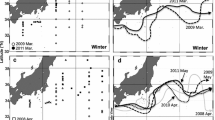Abstract
Concentrations of pelagic fungal biomass, determined as the content of ergosterol in particulate matter, were measured in 49 Baltic rivers during summer 1999. The ergosterol concentration varied 12-fold, from 12.6 to 152.5 ng l−1 (average of 56.4 ng l−1) and correlated positively with concentrations of dissolved organic matter and inorganic nutrients as well as with spectral DOM properties indicative of terrestrial sources. The fungal biomass was 12- to 100-fold lower than the biomass of pelagic bacteria, suggesting that fungi in the water column of the rivers probably were of minor importance in the riverine ecosystems at the sampling time.


Similar content being viewed by others
References
Ágoston-Szabó, E., M. Dinka, L. Némedi & G. Horváth, 2006. Decomposition of Phragmites australis rhizome in a shallow lake. Aquatic Botany 85: 311–318.
Amon, R. M. W. & R. Benner, 1998. Seasonal patterns of bacterial abundance and production in the Mississippi River plume and their importance for the fate of enhanced primary production. Microbial Ecology 35: 289–300.
Baldy, V., M. O. Gessner & E. Chauvet, 1995. Bacteria, fungi and the breakdown of leaf-litter in a large river. Oikos 74: 93–102.
Bärlocher, F., 1985. The role of fungi in the nutrition of stream invertebrates. Botanical Journal of the Linnean Society 91: 83–94.
Bärlocher, F. & H. Brendelberger, 2004. Clearance of aquatic hyphomycete spores by a benthic suspension feeder. Limnology and Oceanography 49: 2292–2296.
Bergfur, J., R. K. Johnson, L. Sandin, W. Goedkoop & K. Nygren, 2007. Effects of nutrient enrichment on boreal streams: invertebrates, fungi and leaf-litter breakdown. Freshwater Biology 52: 1618–1633.
Davies-Colley, R. J. & W. N. Vant, 1987. Absorption of light by yellow substance in freshwater lakes. Limnology and Oceanography 32: 416–425.
Davis, M. W. & R. T. Lamar, 1992. Evaluation of methods to extract ergosterol for quantitation of soil fungal biomass. Soil Biology & Biochemistry 24: 189–198.
de Haan, H., 1972. Molecule-size distribution of soluble humic compounds from different natural waters. Freshwater Biology 2: 235–241.
Gessner, M. O. & E. Chauvet, 1993. Ergosterol-to-biomass conversion factors for aquatic hyphomycetes. Applied and Environmental Microbiology 59: 502–507.
Gessner, M. O., M. A. Bauchrowitz & M. Escautier, 1991. Extraction and quantification of ergosterol as a measure of fungal biomass in leaf litter. Microbial Ecology 22: 285–291.
Gulis, V., K. Suberkropp & A. D. Rosernond, 2008. Comparison of fungal activities on wood and leaf litter in unaltered and nutrient-enriched headwater streams. Applied and Environmental Microbiology 74: 1094–1101.
Iqbal, S. H. & J. Webster, 1973. Aquatic hyphomycete spora of River Exe and its tributaries. Transactions of the British Mycological Society 61: 331–346.
McKnight, D. M. & G. R. Aiken, 1998. Sources and age of aquatic humus. In Hessen, D. O. & L. J. Tranvik (eds), Aquatic humic substances. Springer-Verlag, Heidelberg: 9–40.
Mille-Lindblom, C. & L. J. Tranvik, 2003. Antagonism between bacteria and fungi on decomposing aquatic plant litter. Microbial Ecology 45: 173–182.
Mille-Lindblom, C., H. Fischer & L. J. Tranvik, 2006. Litter-associated bacteria and fungi—a comparison of biomass and communities across lakes and plant species. Freshwater Biology 51: 730–741.
Newell, S. Y. & A. Statzell-Tallman, 1982. Factors for conversion of fungal biovolume values to biomass, carbon and nitrogen—variation with mycelial ages, growth-conditions, and strains of fungi from a salt-marsh. Oikos 39: 261–268.
Pascoal, C. & F. Cassio, 2004. Contribution of fungi and bacteria to leaf litter decomposition in a polluted river. Applied and Environmental Microbiology 70: 5266–5273.
Sole, M., I. Fetzer, R. Wennrich, K. R. Sridhar, H. Harms & G. Krauss, 2008. Aquatic hyphomycete communities as potential bioindicators for assessing anthropogenic stress. Science of the Total Environment 389: 557–565.
Sridhar, K. R. & F. Bärlocher, 2000. Initial colonization, nutrient supply, and fungal activity on leaves decaying in streams. Applied and Environmental Microbiology 66: 1114–1119.
Sridhar, K. R., K. S. Karamchand & R. Bhat, 2006. Arboreal water-borne hyphomycetes on oak-leaf basket fern Drynaria quercifolia. Sydowia 58: 309–320.
Stålnacke, P., A. Grimvall, K. Sundblad & A. Tonderski, 1999. Estimation of riverine loads of nitrogen and phosphorus to the Baltic Sea, 1970–1993. Environmental Monitoring and Assessment 58: 173–200.
Stepanauskas, R., H. Laudon & N. O. G. Jørgensen, 2000. High DON bioavailability in boreal streams during a spring flood. Limnology and Oceanography 45: 1298–1307.
Stepanauskas, R., N. O. G. Jørgensen, O. R. Eigaard, A. Zvikas, L. J. Tranvik & L. Leonardson, 2002. Summer inputs of riverine nutrients to the Baltic Sea: bioavailability and eutrophication relevance. Ecological Monographs 72: 579–597.
Acknowledgements
This work was supported by MISTRA and the Oscar and Lili Lamms Minne Fundation for R. Stepanauskas. We wish to thank R. E. Jensen for skillful assistance with analysis of ergosterol, and Drs. M. Sole, K. R. Sridhar and M.O. Gessner for valuable help and advice during preparation of the manuscript. We also acknowledge the constrictive criticism of the manuscript by three reviewers.
Author information
Authors and Affiliations
Corresponding author
Additional information
Handling editor: J. Padisak
Rights and permissions
About this article
Cite this article
Jørgensen, N.O.G., Stepanauskas, R. Biomass of pelagic fungi in Baltic rivers. Hydrobiologia 623, 105–112 (2009). https://doi.org/10.1007/s10750-008-9651-2
Received:
Revised:
Accepted:
Published:
Issue Date:
DOI: https://doi.org/10.1007/s10750-008-9651-2




